myredracer wrote:
That Camco filter is only 100 microns and will not filter out any bacteria. It will prevent bacteria from growing inside it though. Camco filter info.
Even if you have a low micron filter, you won't filter out all bacteria. Even if you had microfiltration at 0.05 microns, you'd only be filtering some of the bacteria. filtering bacteria
Hi myredracer,
I'm not disagreeing with you, just putting things in perspective. This is more pointed towards your 0.05 microns statement. For camper use, 0.05 microns is impracticable. The common water born organisms found in potable water systems are bigger than that. See this chart to help explain what is what size. This if from a large RO membrane manufacture.
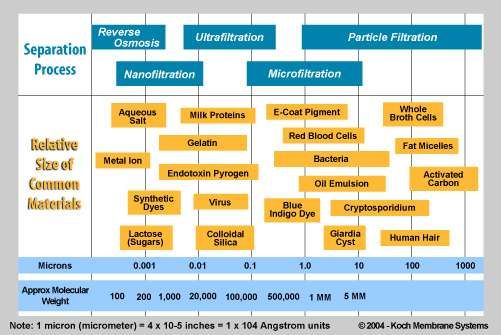
To the rest of the folks, I'll add my thoughts as we seem to have found many who have also tried to figure out water in their campers and I can tell by the responses some have drilled down into this. I'm not a microbiologist and do not claim to be, however I do work on machinery for a living that has to keep microorganisms under control in water many times more clean then potable water.
0.1 micron is the size that some backpacking water purifiers have. Stick the hose in the lake, pump it and out comes clean water safe from the common water born organisms and virus's. However that fine a size can and will clog really fast trying to use it to filter a 38 gallon fresh tank. When you get something that fine for a camper, it is usually a point of use filter. You have filtered water in the fresh tank and then double filter with a 0.1 micron right before the sink. I have used these ceramic carbon and then pleated filters for backpacking. MSR makes them and so does Pur I think.
Now the camper. I myself would not leave a point of use filter full between trips if your trips are weeks or a month apart and then add summer temps that can get to 100F inside the camper. Us weekend warriors have different needs then the full timers.
When I fill my fresh tank at my own home, I do not filter the water as I know the source. After that... everything else is filtered. CG's can be a free for all. I use a 0.9 micron ceramic carbon filter. It is a Camco unit and may or may not be available any more. I have some spare filters for it and once they are gone I might have to find plan B. It is a love hate relationship with this filter. I like the action it gives, I can see the build up and I can clean it. It has KDF to keep the carbon biostatic (bugs don't grow) in it and I dry it out in the sun after each use.
Here is what one CG left me with 1 fill up of 38 gallons. Yummy. While it may be potable, I sure do not want that sediment in my camper.
Here they are after filling 1 tank
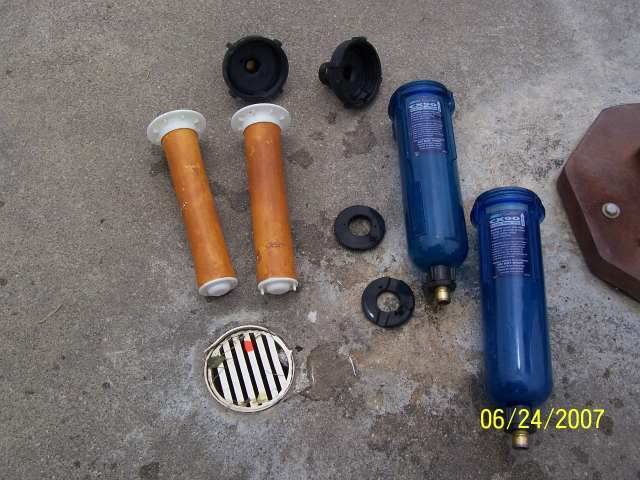
the cleaning process
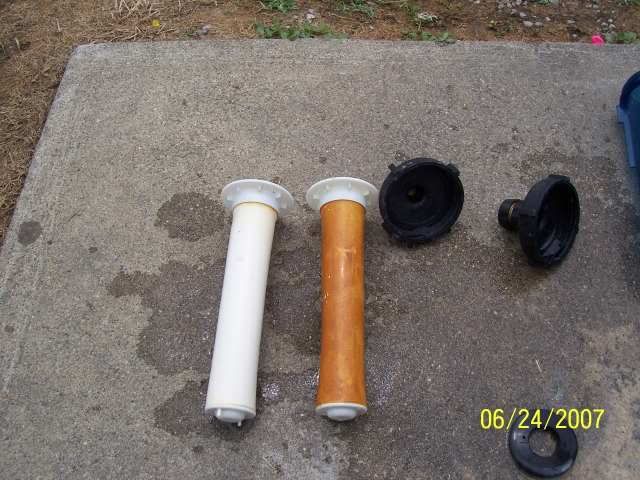
all done
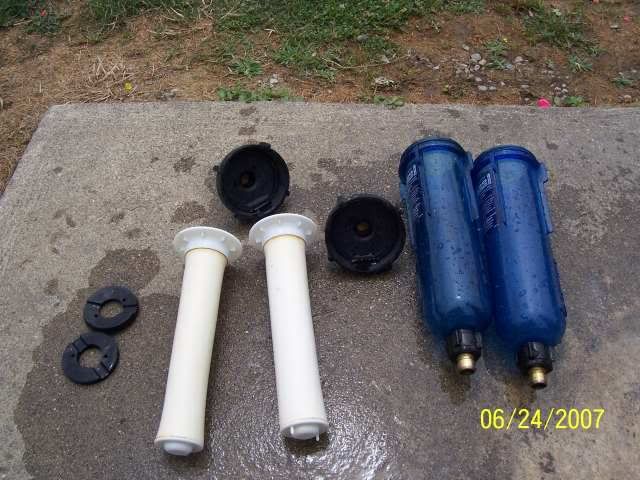
Here is another state park on full hook up. This was white when I started on Friday.
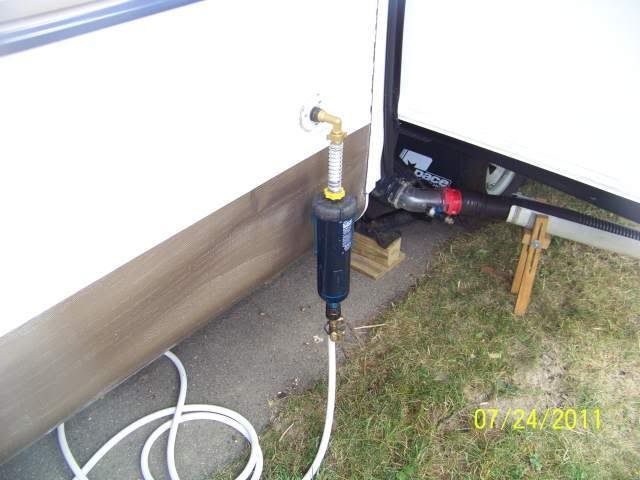
And the filter pulled out on Sunday
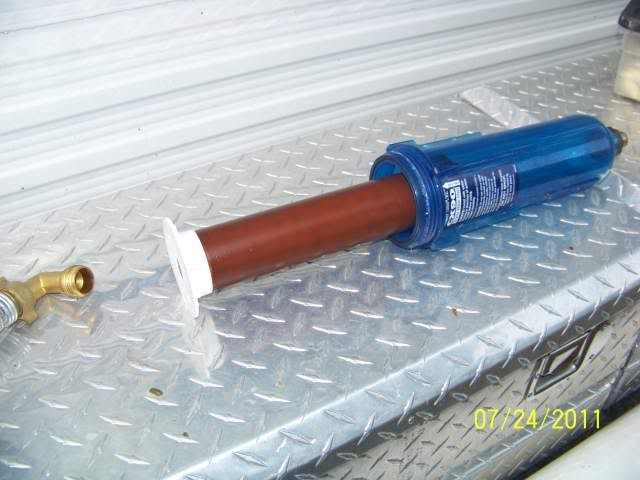
There is for sure a need to filter. The hate part of this filter is the fragile nature of it. You can crack off the top really easy. It may have been why Camco stopped pushing it.
On CG's with high iron, this 0.9 micron is not good. It will plug trying to get 15 gallons of water through it. In this case I use the 100 micron Camco blue filter shown by others and buy then in a 2 pack from various places. Wal-Mart and others.
As was said, carbon filters do strip out/reduce chlorine. A water tap that has 3.5ppm free chlorine in it will be reduced to approx. 1.0 ppm being filtered through the 0.9 micron ceramic carbon filter. Some CG's in the spring spike the chlorine up close to the limit to kill off the system when it first comes on line after the winter. During the summer it is not that high on the incoming water.
Point is, the carbon filter reduces the chlorine, how much gets through depends on what the level was when it started and the micron rating of the filter. Start out with 1.5ppm chlorine and pass through 0.9 micorn may end up 0.3 to 0.5 ppm chlorine in one pass.
I do measure system chlorine and spike it with unscented bleach as needed. This is not hard to do once you figure out your system. I target for 0.5 to 0.8 ppm range on a known clean system. I may be on the extreme end of the water curve but again this comes back to my background.
Something else not mentioned is draining the system. When we weekend camp, I drain the system after every campout including the HW heater and have it set up with a double filtration compressed air blow out system. Only takes me about 10 minutes as I unpack the camper. Drain HW heater at camp through a valved drain, have low point drains and faucets open while in route home and not much water left after to blow out. If we are on our 3 week camping trip, it stays full the whole time and I monitor chlorine every time I add more filtered fresh water.
Another tid bit of info, a 38 gallon fresh tank starting with 3.5ppm chlorine will flash off the chlorine close to 0ppm after 4 days with 85F temps during the day. The tank is vented, the water lowers with use so the air in the tank goes up so it flashes off even that much quicker. Chlorine is just dying to flash off into nothing from the time it leaves the bottle. Bleach that is old or the cap left off very long turns close to plain water.
Another must is to sanitize the system 1 or 2 times a year pending your use. Start with a clean system, only add known good potable water to it, filter incoming water if it is not your source, a chlorine check is a good thing to do and drain the system in periods of non use and drink from the camper without concerns.
Thanks for the tip on the whole house filter. Never thought of that. It may be my new source if I cannot get the Camco's any more.
John





